ARION: A Digital eLearning Educational Tool Library for Synchronization Composition & Orchestration of Learning Session Data
Abstract
:1. Introduction
2. Background Work
2.1. Data Orchestration
2.1.1. Current Technological Trends in the Steps of Data Orchestration
Organize
Transform
Activate
2.1.2. Orchestration in Learning
2.2. Video & Audio Synchronization
Techniques
2.3. Data Visualization
2.4. Learning Analytics: The Experience API
3. ARION: An Educational Data Orchestration Software
ARION Software Architecture
4. ARION: Experiment and Scenario of Use
5. Results and Discussion
5.1. The Purpose
5.2. The Method
5.3. The Learning Session
5.4. The Evaluation Session
5.4.1. Result/Deduced Evaluation Statement for Figure 13a

5.4.2. Result/Deduced Evaluation Statement for Figure 13b
5.4.3. Result/Deduced Evaluation Statement for Figure 13c
5.4.4. Result/Deduced Evaluation Statement for Figure 13d
6. Conclusions
Author Contributions
Funding
Institutional Review Board Statement
Informed Consent Statement
Conflicts of Interest
References
- Kopp, M.; Gröblinger, O.; Adams, S. Five common assumptions that prevent digital transformation at higher education institutions. In Proceedings of the INTED 2019, Valencia, Spain, 11–13 March 2019; pp. 1448–1457. [Google Scholar] [CrossRef]
- Ustun, G. Determining depression and related factors in a society affected by COVID-19 pandemic. Int. J. Soc. Psychiatry 2020, 67, 54–63. [Google Scholar] [CrossRef]
- Carte, R.A.; Rice, M.; Yang, S.; Jackson, H.A. Self-regulated learning in online learning environments: Strategies for remote learning. Inf. Learn. Sci. 2020, 121, 311–319. [Google Scholar] [CrossRef]
- Favale, T.; Soro, F.; Trevisan, M.; Drago, I.; Mellia, M. Campus traffic and e-Learning during COVID-19 pandemic. Comput. Netw. 2020, 176, 107290. [Google Scholar] [CrossRef]
- George, M.L. Effective Teaching and Examination Strategies for Undergraduate Learning during COVID-19 School Restrictions. J. Educ. Technol. Syst. 2020, 49, 23–48. [Google Scholar] [CrossRef]
- García-Morales, V.J.; Garrido-Moreno, A.; Martín-Rojas, R. The Transformation of Higher Education after the COVID Disruption: Emerging Challenges in an Online Learning Scenario. Front. Psychol. 2021, 12, 616059. [Google Scholar] [CrossRef]
- Hodges, C.; Moore, S.; Lockee, B.; Trust, T.; Bond, A. The Difference between Emergency Remote Teaching and Online Learning. Educause Review. 2020. Available online: https://er.educause.edu/articles/2020/3/the-differencebetween-emergency-remote-teaching-and-online-learning (accessed on 25 January 2021).
- Abt, C.C. Serious Games; L.C. 79-83234; Viking: New York, NY, USA, 1970; 176p. [Google Scholar] [CrossRef]
- Ulicsak, M. Games in Education: Serious Games. In A FutureLab Literature Review; FutureLab: Kuala Lumpur, Malaysia, 2010; p. 139. [Google Scholar]
- Zyda, M. From visual simulation to virtual reality to games. Computer 2005, 38, 25–32. [Google Scholar] [CrossRef]
- Arnab, S.; Lim, T.; Carvalho, M.B.; Bellotti, F.; de Freitas, S.; Louchart, S.; Suttie, N.; Berta, R.; de Gloria, A. Mapping learning and game mechanics for serious games analysis. Br. J. Educ. Technol. 2015, 46, 391–411. [Google Scholar] [CrossRef]
- Bellotti, F.; Kapralos, B.; Lee, K.; Moreno-Ger, P.; Berta, R. Assessment in and of serious games: An overview. Adv. Hum. Comput. Interact. 2013, 2013, 1. [Google Scholar] [CrossRef] [Green Version]
- Paulsen, M. Online Education Systems in Scandinavian and Australian Universities: A Comparative Study. International Review of Research in Open and Distance Learning; NKI Distance Education: Oslo, Norway, 2002; Volume 3, pp. 1–8, Number 2; ISSN 1492-3831. [Google Scholar] [CrossRef]
- Hurtado, C.; Licea, G.; Garcia-Valdez, M. Integrating Learning Styles in an Adaptive Hypermedia System with Adaptive Resources. Stud. Syst. Decis. Control 2018, 143, 49–67. [Google Scholar] [CrossRef]
- Katsaris, I.; Vidakis, N. Adaptive e-learning systems through learning styles: A review of the literature. Adv. Mob. Learn. Educ. Res. 2022, 1, 124–145. [Google Scholar] [CrossRef]
- Lazarinis, F.; Boididis, I.; Kozanidis, L.; Kanellopoulos, D. An adaptable multi-learner serious game for learning cultural heritage. Adv. Mob. Learn. Educ. Res. 2022, 2, 201–215. [Google Scholar] [CrossRef]
- Brusilovsky, P. Adaptive Hypermedia for Education and Training. Adaptive Technologies for Training and Education; Cambridge University Press: Cambridge, UK, 2012; pp. 46–66. [Google Scholar] [CrossRef]
- Liu, X.; Liu, Y.; Song, H.; Liu, A. Big Data Orchestration as a Service Network. IEEE Commun. Mag. 2017, 55, 94–101. [Google Scholar] [CrossRef]
- Peltz, C. Web services orchestration and choreography. Computer 2003, 36, 46–52. [Google Scholar] [CrossRef]
- Tabak, I. Synergy: A Complement to Emerging Patterns of Distributed Scaffolding. J. Learn. Sci. 2004, 13, 305–335. [Google Scholar] [CrossRef]
- Ryan, S. What Is Data Orchestration. 2020. Available online: https://www.mparticle.com/blog/data-orchestration (accessed on 26 January 2022).
- Natriello, G. Imagining, seeking, inventing: The future of learning and the emerging discovery networks. Learn. Inq. 2007, 1, 7–18. [Google Scholar] [CrossRef]
- Prieto, L.P.; Dimitriadis, Y.; Asensio-Pérez, J.I.; Looi, C.K. Orchestration in learning technology research: Evaluation of a conceptual framework. Res. Learn. Technol. 2015, 23, 1–15. [Google Scholar] [CrossRef] [Green Version]
- Watts, M. The orchestration of learning and teaching methods in science education. Can. J. Sci. Math. Technol. Educ. 2003, 3, 451–464. [Google Scholar] [CrossRef]
- Dillenbourg, P.; Jermann, P. Designing Integrative Scripts. In Scripting Computer-Supported Collaborative Learning; Springer: Boston, MA, USA, 2007; pp. 275–301. [Google Scholar] [CrossRef]
- Liang, J.; Huang, P.; Chen, J.; Hauptmann, A. Synchronization for multi-perspective videos in the wild. In Proceedings of the 2017 IEEE International Conference on Acoustics, Speech and Signal Processing (ICASSP), New Orleans, LA, USA, 5–9 March 2017; IEEE: Piscataway, NJ, USA, 2017; pp. 1592–1596. [Google Scholar] [CrossRef]
- Kammerl, J.; Birkbeck, N.; Inguva, S.; Kelly, D.; Crawford, A.J.; Denman, H.; Kokaram, A.; Pantofa, C. Temporal synchronization of multiple audio signals. In Proceedings of the 2014 IEEE International Conference on Acoustics, Speech and Signal Processing (ICASSP), Florence, Italy, 4–9 May 2014; IEEE: Piscataway, NJ, USA, 2014; pp. 4603–4607. [Google Scholar] [CrossRef]
- Lu, C.; Mandal, M. An efficient technique for motion-based view-variant video sequences synchronization. In Proceedings of the 2011 IEEE International Conference on Multimedia and Expo, Barcelona, Spain, 11–15 July 2011; IEEE: Piscataway, NJ, USA, 2011; pp. 1–6. [Google Scholar] [CrossRef]
- Shrestha, P.; Weda, H.; Barbieri, M.; Sekulovski, D. Synchronization of multiple video recordings based on still camera flashes. In Proceedings of the 14th Annual ACM International Conference on Multimedia—MULTIMEDIA ’06, Santa Barbara, CA, USA, 23–27 October 2006; p. 137. [Google Scholar] [CrossRef]
- Shrstha, P.; Barbieri, M.; Weda, H. Synchronization of multi-camera video recordings based on audio. In Proceedings of the 15th International Conference on Multimedia—MULTIMEDIA ’07, Augsburg, Germany, 25–29 September 2007; p. 545. [Google Scholar] [CrossRef]
- Liang, J.; Burger, S.; Hauptmann, A.L.; Aronson, J.L. Video Synchronization and Sound Search for Human Rights Documentation and Conflict Monitoring; Carnegie Mellon University: Pittsburgh, PA, USA, 2018. [Google Scholar] [CrossRef]
- Su, K.; Naaman, M.; Gurjar, A.; Patel, M.; Ellis, D.P.W. Making a Scene. In Proceedings of the 2nd ACM International Conference on Multimedia Retrieval—ICMR ‘12, Hong Kong, China, 5–8 June 2012; p. 1. [Google Scholar] [CrossRef]
- Aparicio, M.; Costa, C.J. Data visualization. Commun. Des. Q. 2015, 3, 7–11. [Google Scholar] [CrossRef]
- Friendly, M. A Brief History of Data Visualization. In Handbook of Data Visualization; Springer: Berlin/Heidelberg, Germany, 2008; pp. 15–56. [Google Scholar] [CrossRef]
- Po, L.; Bikakis, N.; Desimoni, F.; Papastefanatos, G. Linked Data Visualization: Techniques, Tools, and Big Data; (Synthesis Lectures on the Semantic Web: Theory and Technology); Morgan & Claypool Publishers: Williston, VT, USA, 2020; Volume 10, pp. 1–157. [Google Scholar] [CrossRef]
- Wang, Z.; Sundin, L.; Murray-Rust, D.; Bach, B. Cheat Sheets for Data Visualization Techniques. In Proceedings of the 2020 CHI Conference on Human Factors in Computing Systems, Honolulu, HI, USA, 25–30 April 2020; pp. 1–13. [Google Scholar] [CrossRef]
- Lias, T.E. Learning Analytics: The Definitions, the Processes, and the Potential. 2011. Available online: http://learninganalytics.net/LearningAnalyticsDefinitionsProcessesPotential.pdf (accessed on 15 February 2021).
- Vidakis, N.; Charitakis, S. Designing the Learning Process. In Proceedings of the 10th International Conference on Subject-Oriented Business Process Management—S-BPM One ’18, Linz, Austria, 5–6 April 2018; pp. 1–11. [Google Scholar] [CrossRef]
- Rustici Software. Experience API. Available online: https://xapi.com/overview/ (accessed on 26 January 2018).
- Trampas, A.M. Extracting Learning Analytics from Game Based Learning Sessions Generated by Multimodal Data Sources. Master’s Thesis, Hellenic Mediterranean University, Heraklion, Greece, 7 July 2021. [Google Scholar]
- Vidakis, N.; Christinaki, E.; Serafimidis, I.; Triantafyllidis, G. Combining Ludology and Narratology in an Open Authorable Framework for Educational Games for Children: The Scenario of Teaching Preschoolers with Autism Diagnosis. In Lecture Notes in Computer Science; Springer International Publishing: Cham, Switzerland, 2014; pp. 626–636. [Google Scholar] [CrossRef]
- Vidakis, N.; Syntychakis, E.; Kalafatis, K.; Christinaki, E.; Triantafyllidis, G. Ludic Educational Game Creation Tool: Teaching Schoolers Road Safety. In Universal Access in Human-Computer Interaction. Access to Learning, Health and Well-Being; Springer International Publishing: Cham, Switzerland, 2015; pp. 565–576. [Google Scholar] [CrossRef]
- Mohammed, D.Y. The web-based behavior of online learning: An evaluation of different countries during the COVID-19 pandemic. Adv. Mob. Learn. Educ. Res. 2022, 2, 263–267. [Google Scholar] [CrossRef]
- Mamolo, L.A. Students’ evaluation and learning experience on the utilization of Digital Interactive Math Comics (DIMaC) mobile app. Adv. Mob. Learn. Educ. Res. 2022, 2, 375–388. [Google Scholar] [CrossRef]
- Zourmpakis, A.I.; Papadakis, S.; Kalogiannakis, M. Education of preschool and elementary teachers on the use of adaptive gamification in science education. Int. J. Technol. Enhanc. Learn. 2022, 14, 1–16. [Google Scholar] [CrossRef]
- Barianos, A.; Papadakis, A.; Vidakis, N. Content manager for serious games: Theoretical framework and digital platform. Adv. Mob. Learn. Educ. Res. 2022, 2, 251–262. [Google Scholar] [CrossRef]
- Vidakis, N.; Barianos, A.K.; Trampas, A.M.; Papadakis, S.; Kalogiannakis, M.; Vassilakis, K. In-Game Raw Data Collection and Visualization in the Context of the “ThimelEdu” Educational Game; Springer International Publishing: Cham, Switzerland, 2020; Volume 1220. [Google Scholar] [CrossRef]
- Papadakis, S.; Kalogiannakis, M. Evaluating the effectiveness of a game-based learning approach in modifying students’ behavioural outcomes and competence, in an introductory programming course. A case study in Greece. Int. J. Teach. Case Stud. 2019, 10, 235–250. [Google Scholar] [CrossRef]
- Papadakis, S.; Trampas, A.M.; Barianos, A.K.; Kalogiannakis, M.; Vidakis, N. Evaluating the Learning Process: The “ThimelEdu” Educational Game Case Study. In Proceedings of the 12th International Conference on Computer Supported Education (CSEDU 2020), Online, 2–4 May 2020; pp. 290–298. [Google Scholar] [CrossRef]
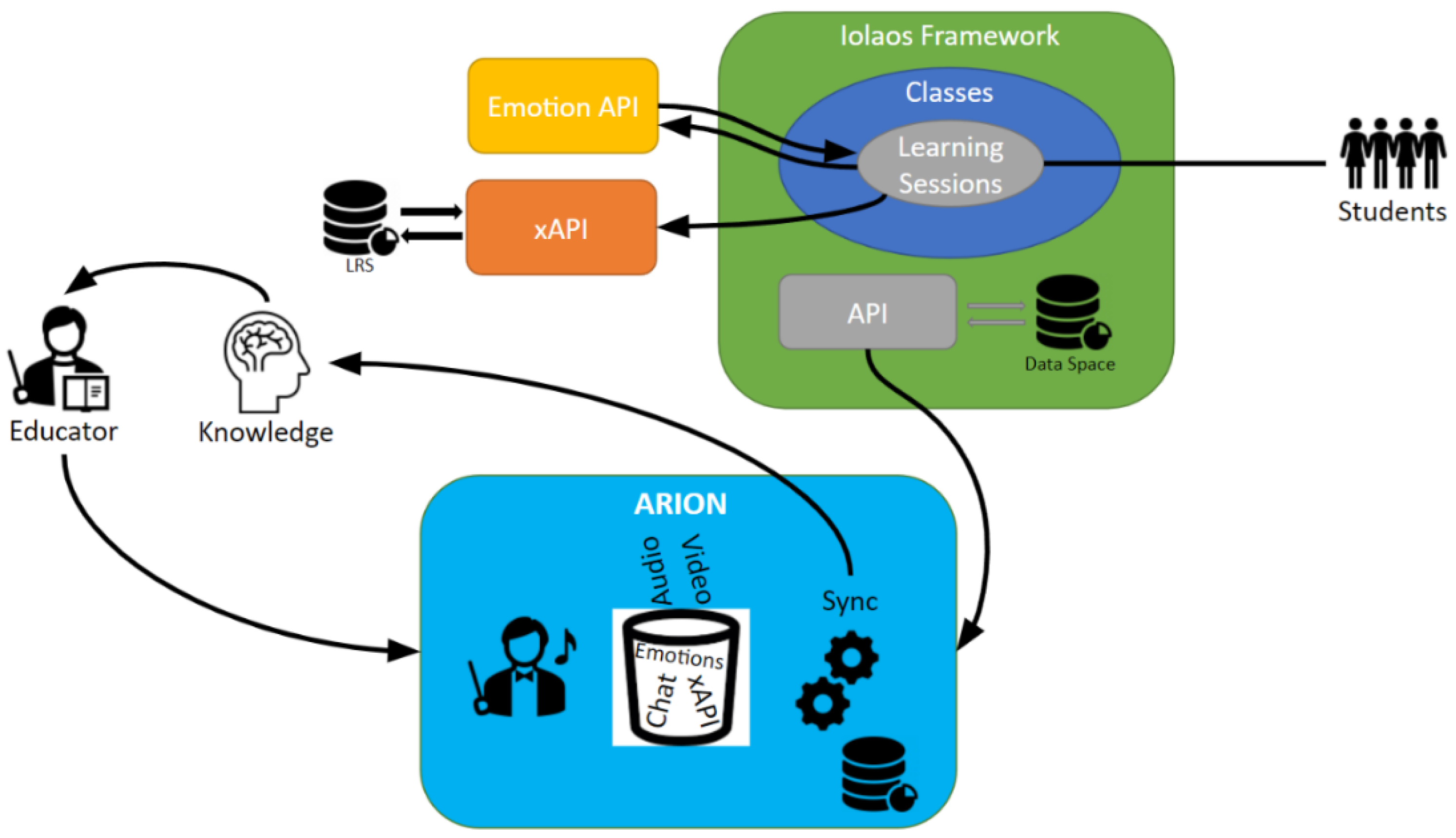
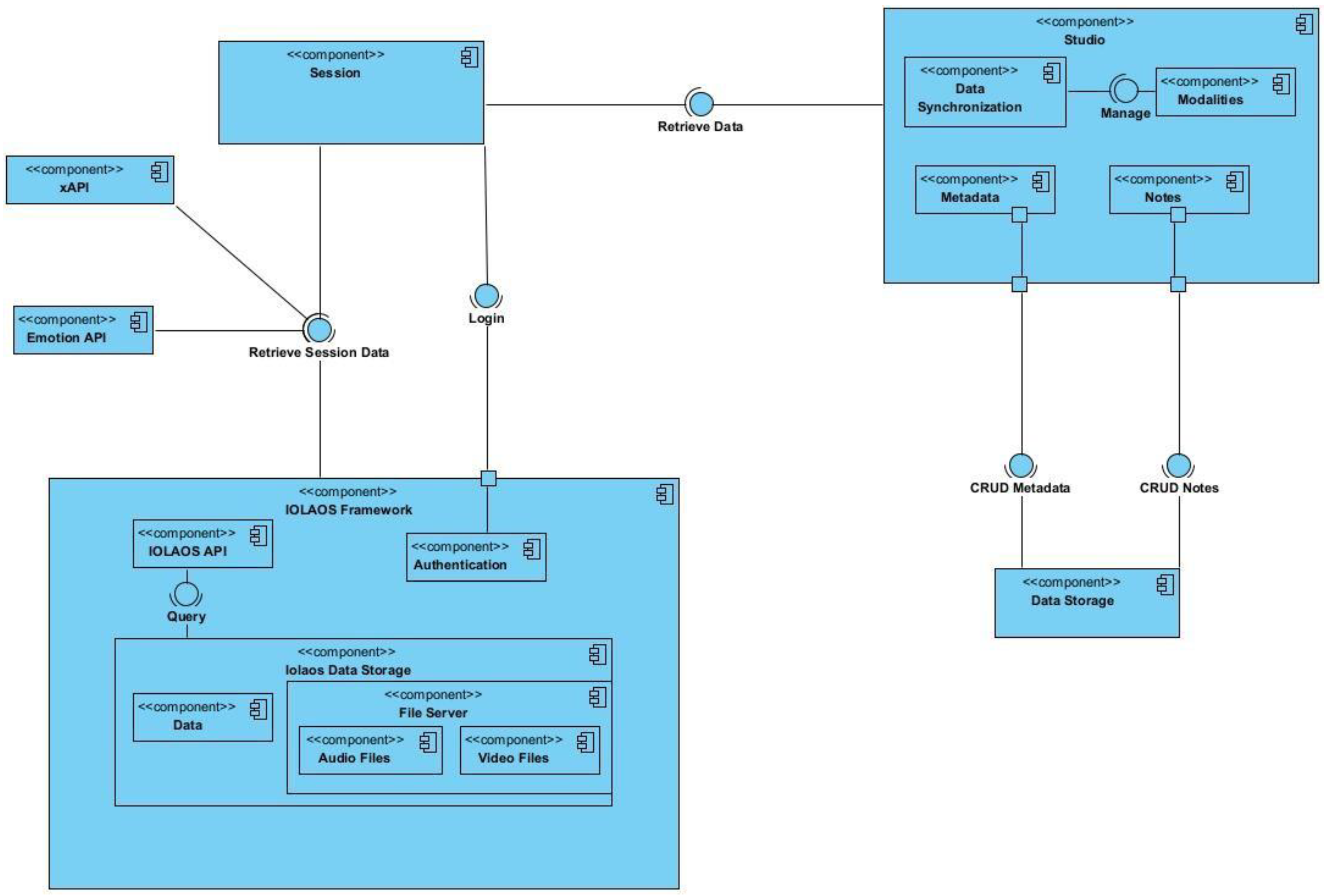
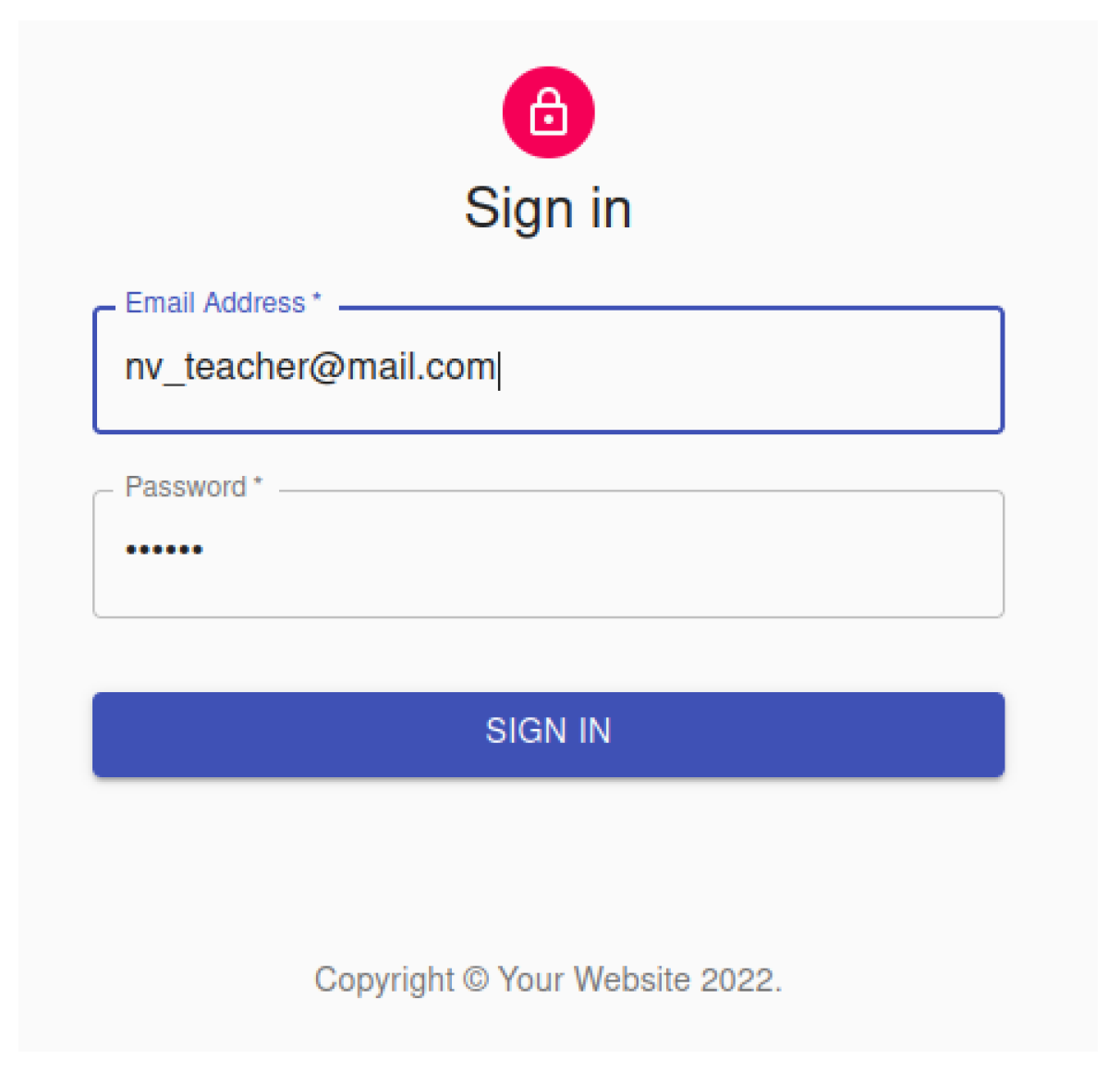
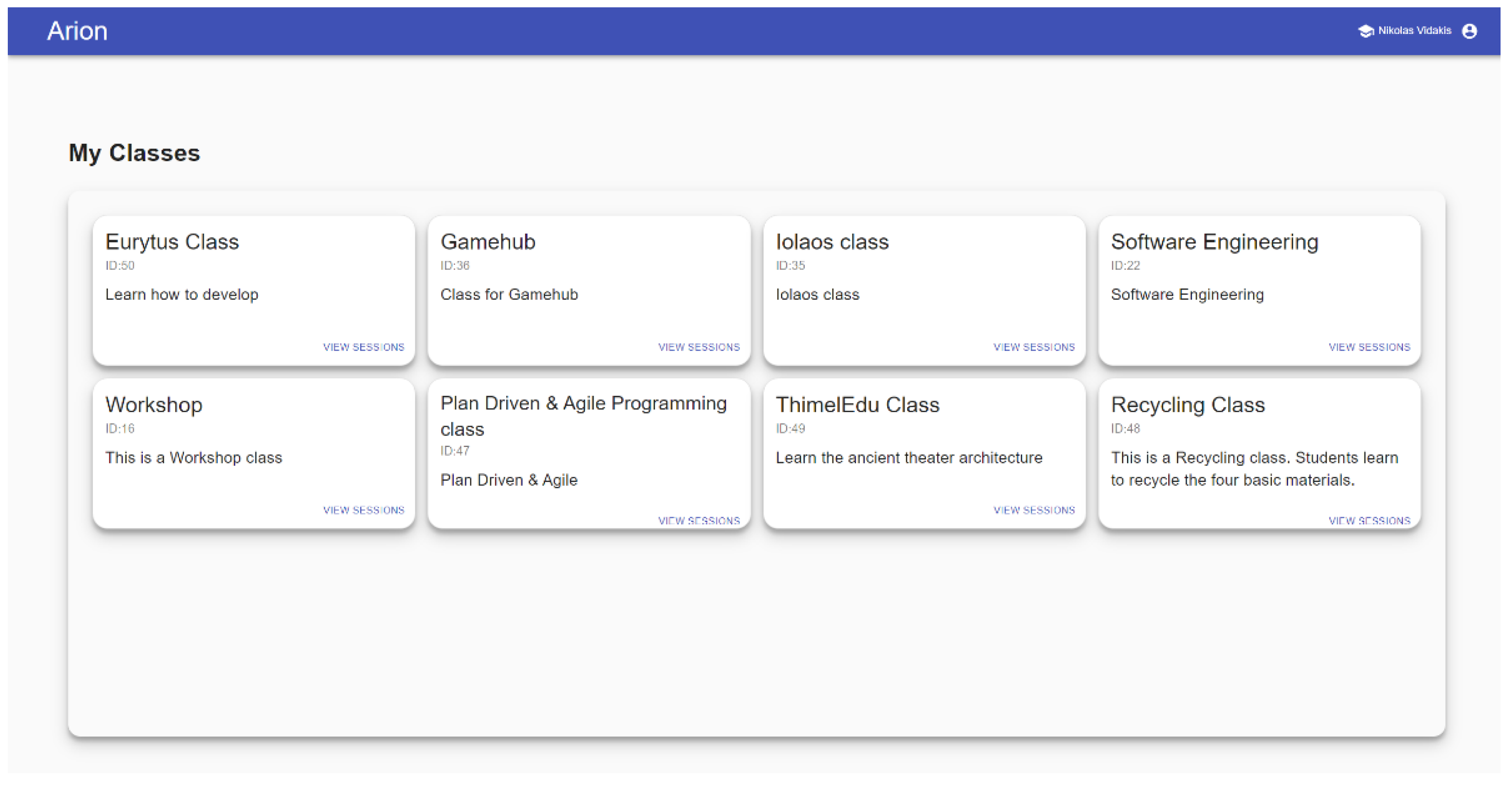
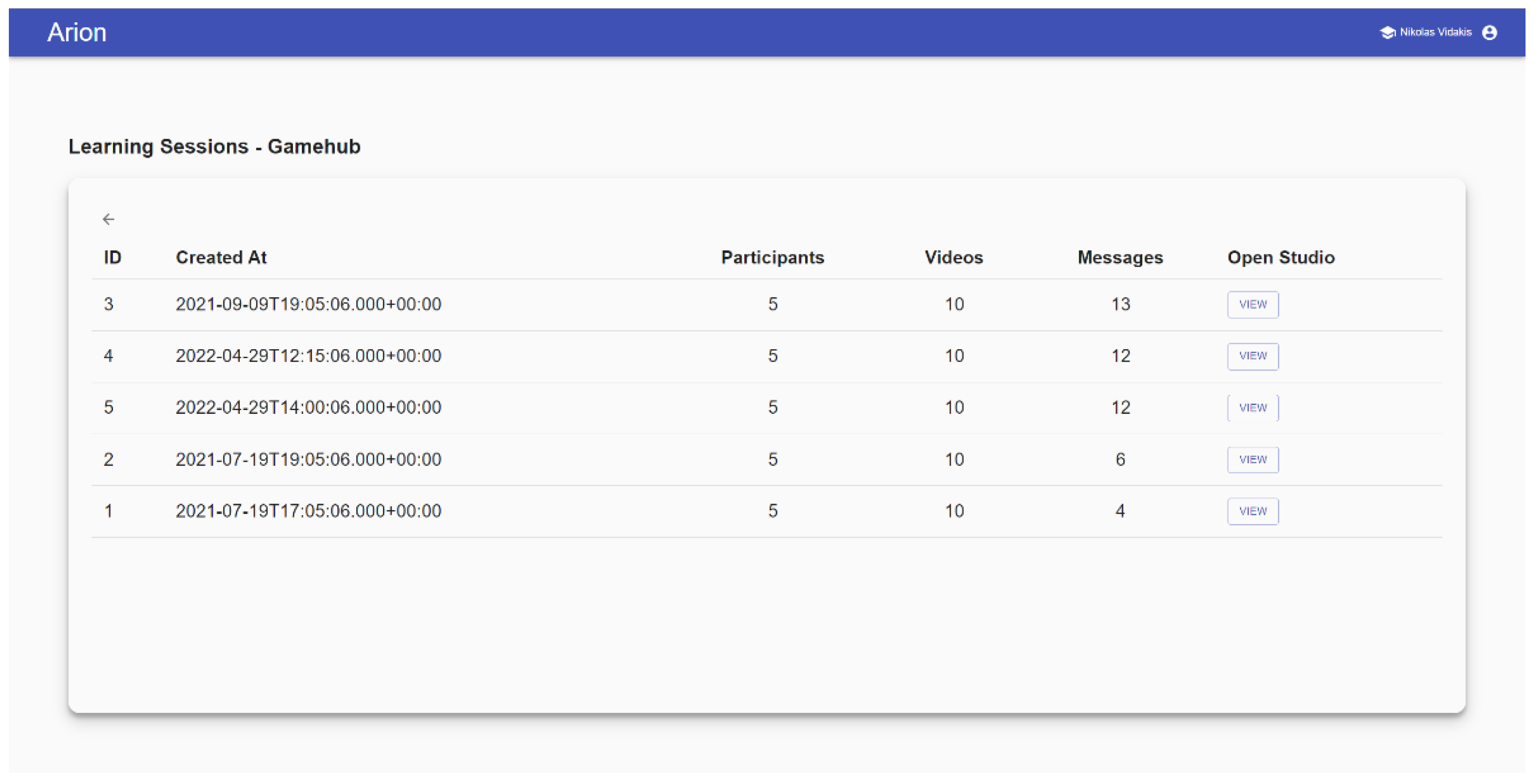
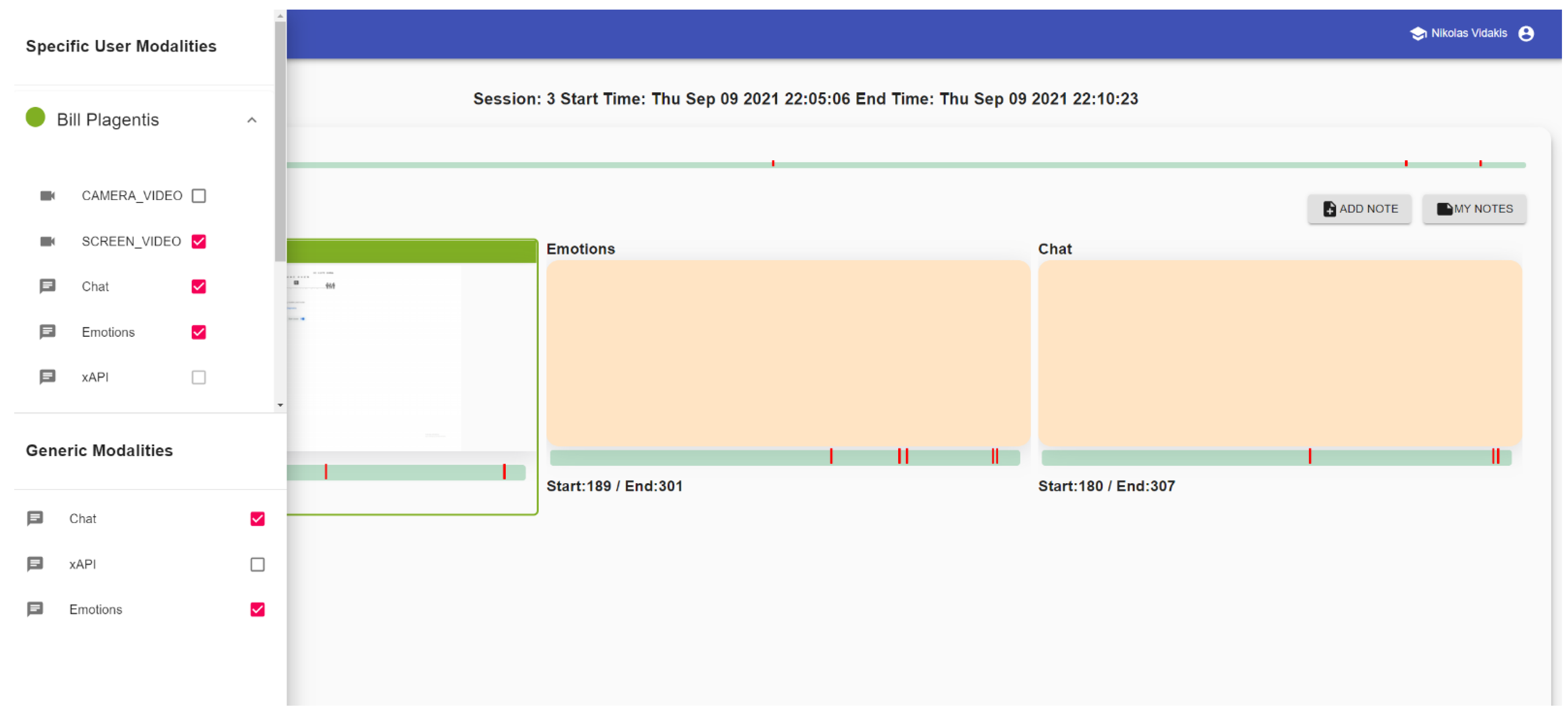

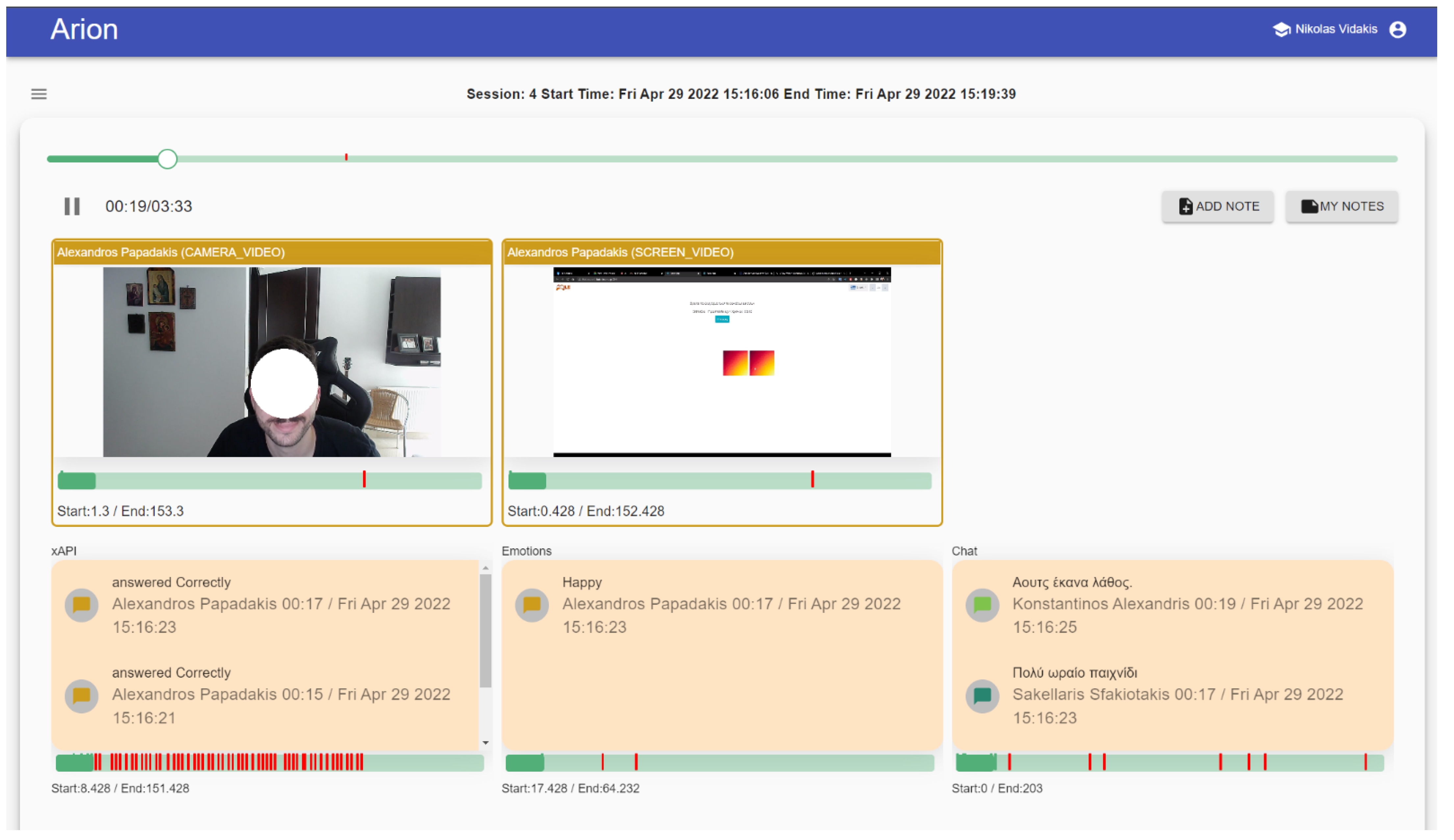
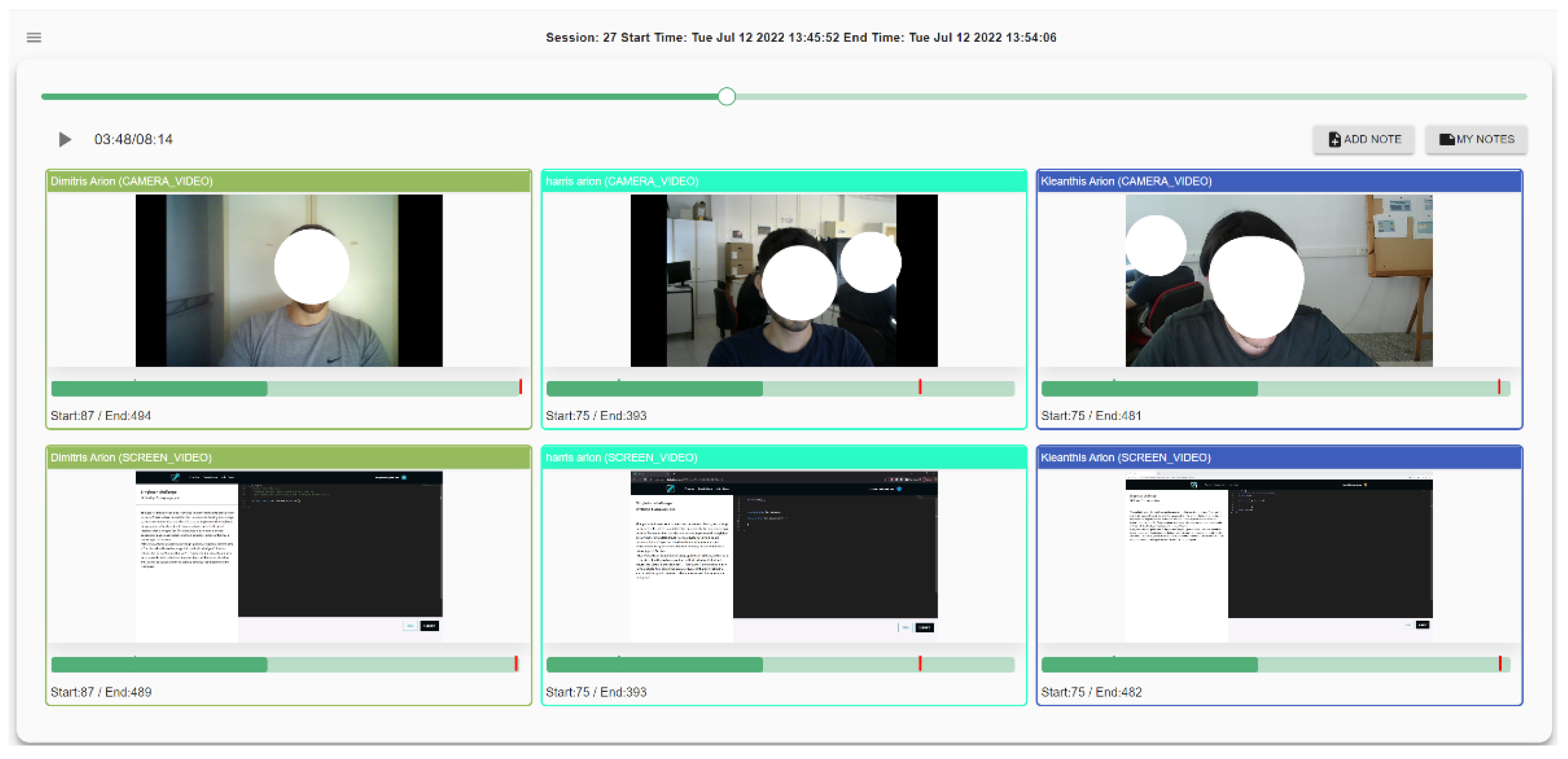
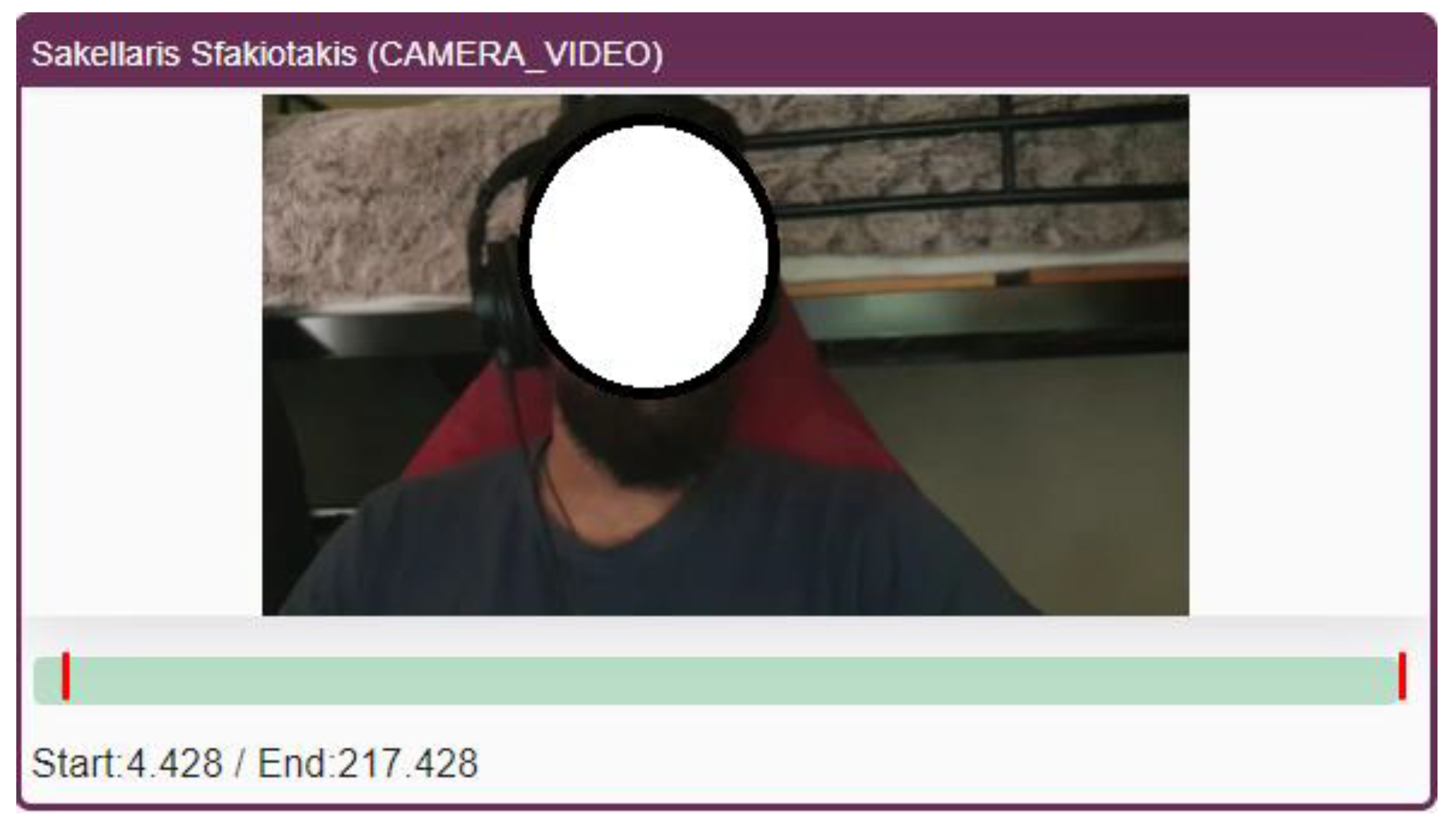

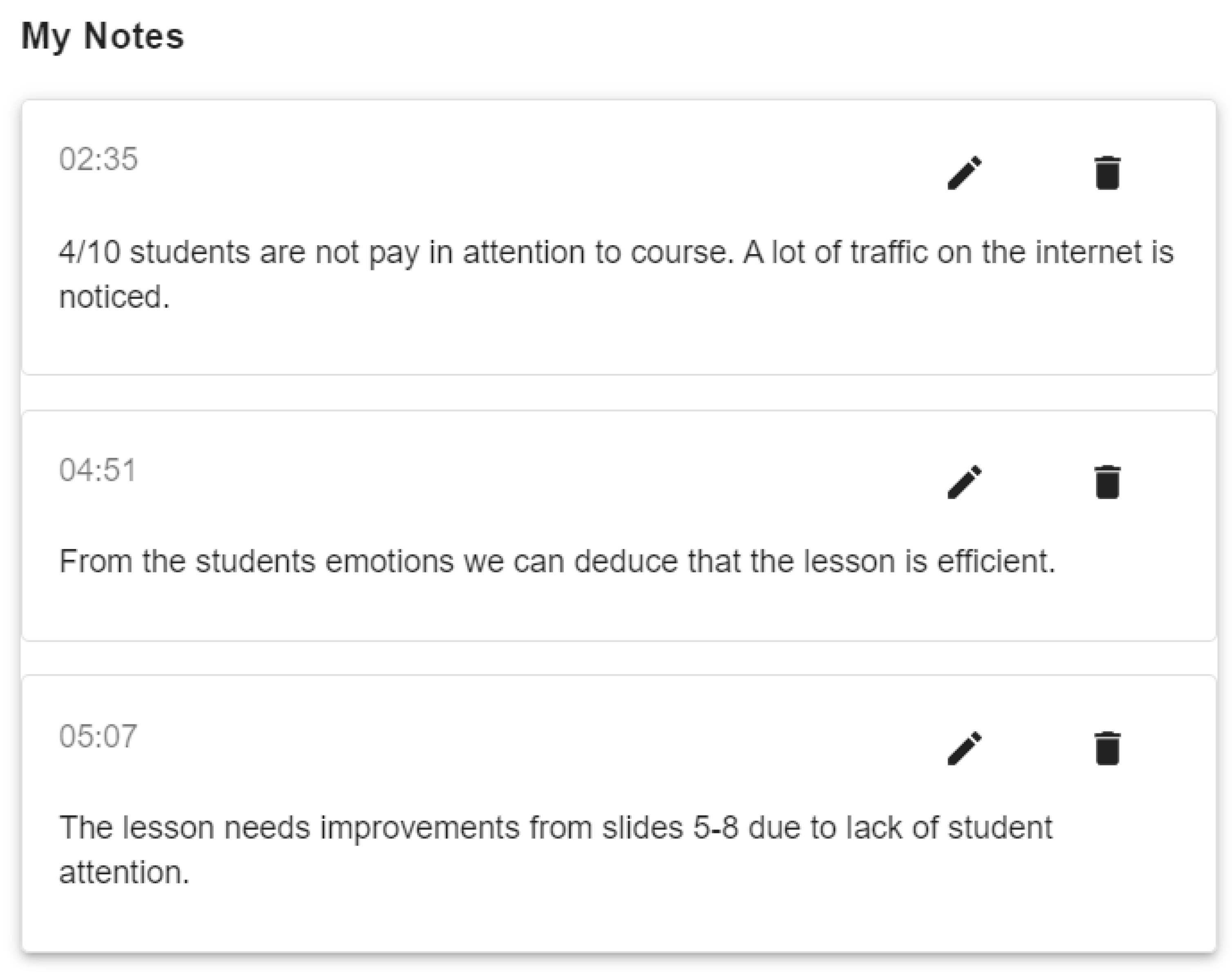
Publisher’s Note: MDPI stays neutral with regard to jurisdictional claims in published maps and institutional affiliations. |
© 2022 by the authors. Licensee MDPI, Basel, Switzerland. This article is an open access article distributed under the terms and conditions of the Creative Commons Attribution (CC BY) license (https://creativecommons.org/licenses/by/4.0/).
Share and Cite
Papadakis, A.; Barianos, A.; Kalogiannakis, M.; Papadakis, S.; Vidakis, N. ARION: A Digital eLearning Educational Tool Library for Synchronization Composition & Orchestration of Learning Session Data. Appl. Sci. 2022, 12, 8722. https://doi.org/10.3390/app12178722
Papadakis A, Barianos A, Kalogiannakis M, Papadakis S, Vidakis N. ARION: A Digital eLearning Educational Tool Library for Synchronization Composition & Orchestration of Learning Session Data. Applied Sciences. 2022; 12(17):8722. https://doi.org/10.3390/app12178722
Chicago/Turabian StylePapadakis, Alexandros, Anastasios Barianos, Michail Kalogiannakis, Stamatios Papadakis, and Nikolas Vidakis. 2022. "ARION: A Digital eLearning Educational Tool Library for Synchronization Composition & Orchestration of Learning Session Data" Applied Sciences 12, no. 17: 8722. https://doi.org/10.3390/app12178722
APA StylePapadakis, A., Barianos, A., Kalogiannakis, M., Papadakis, S., & Vidakis, N. (2022). ARION: A Digital eLearning Educational Tool Library for Synchronization Composition & Orchestration of Learning Session Data. Applied Sciences, 12(17), 8722. https://doi.org/10.3390/app12178722








